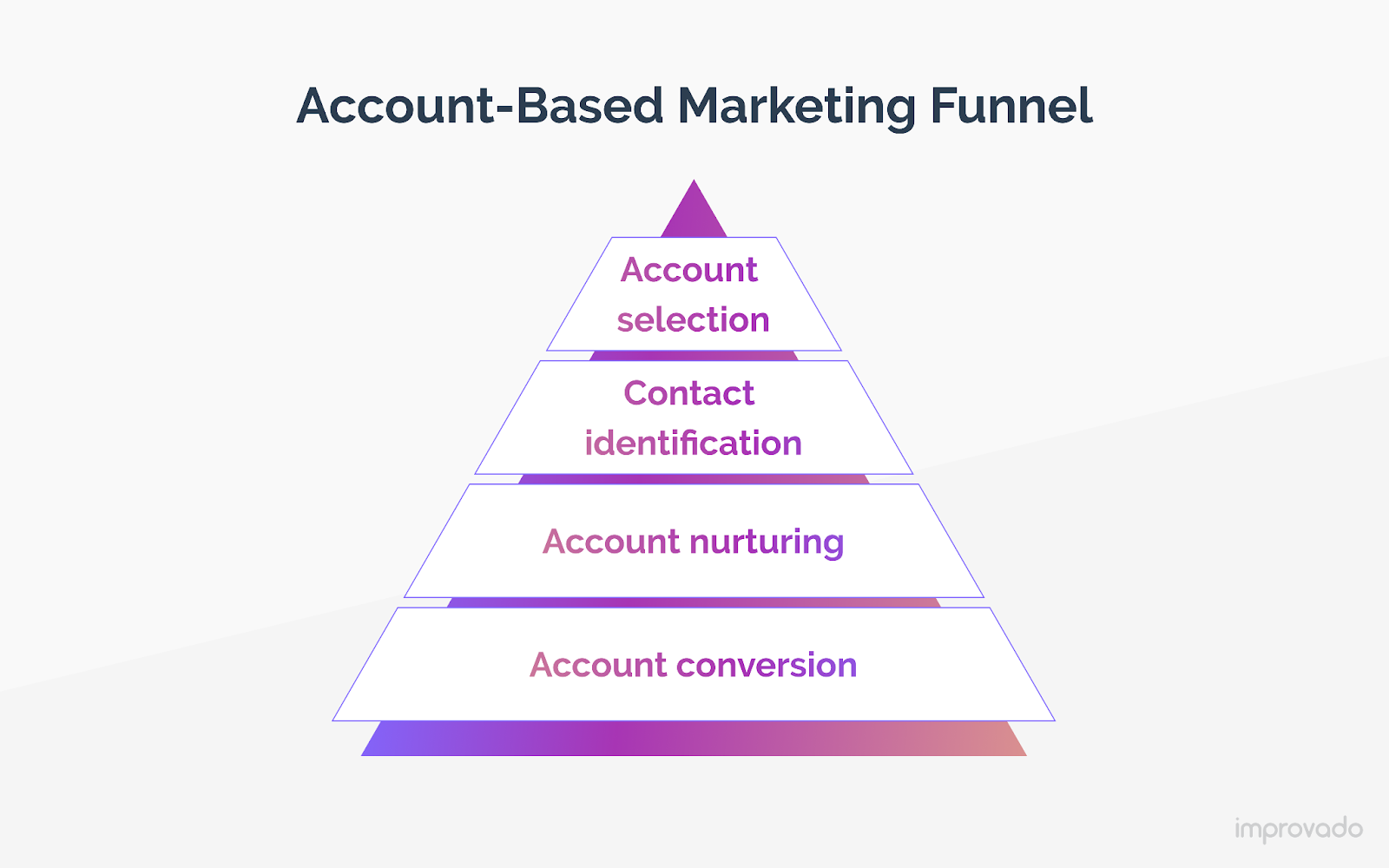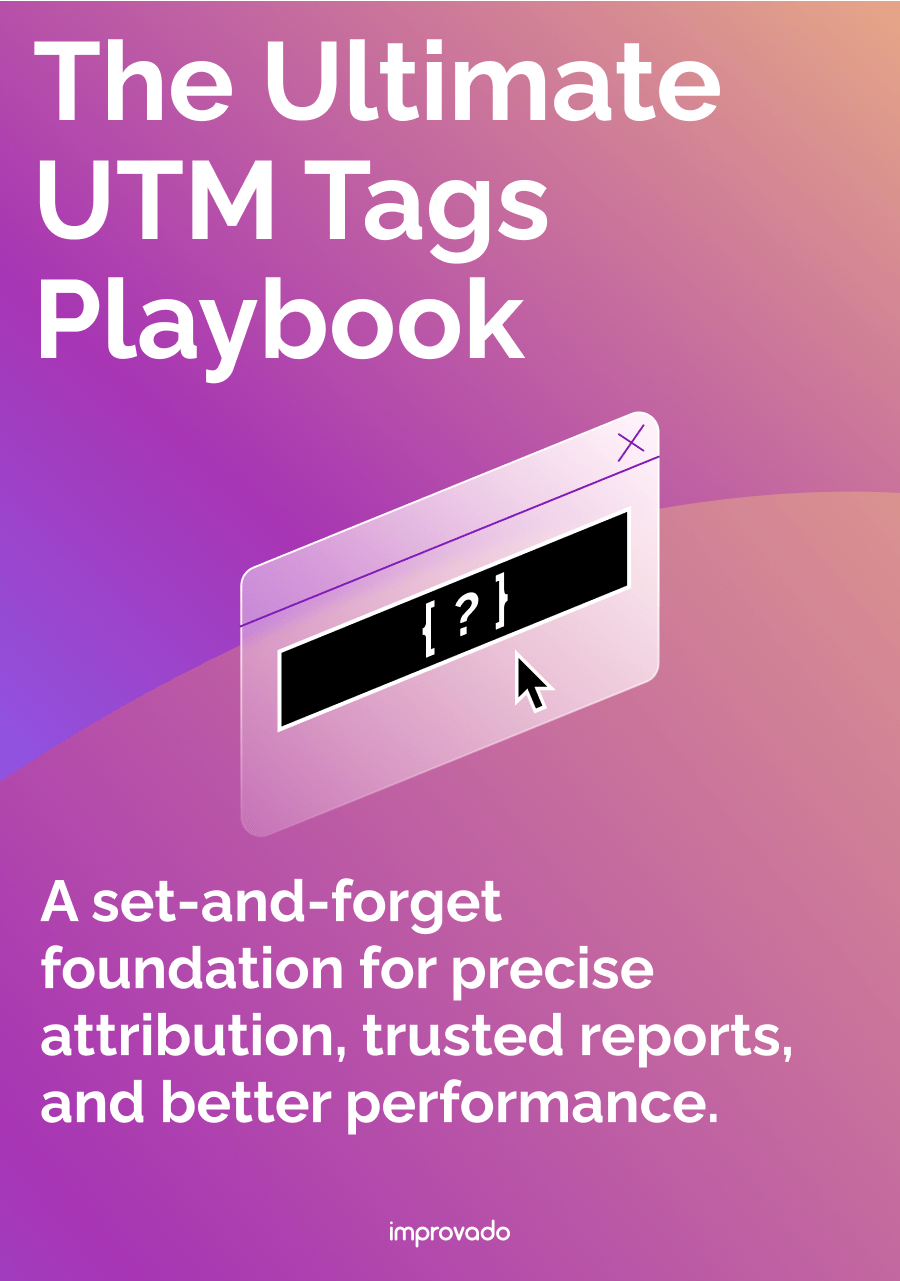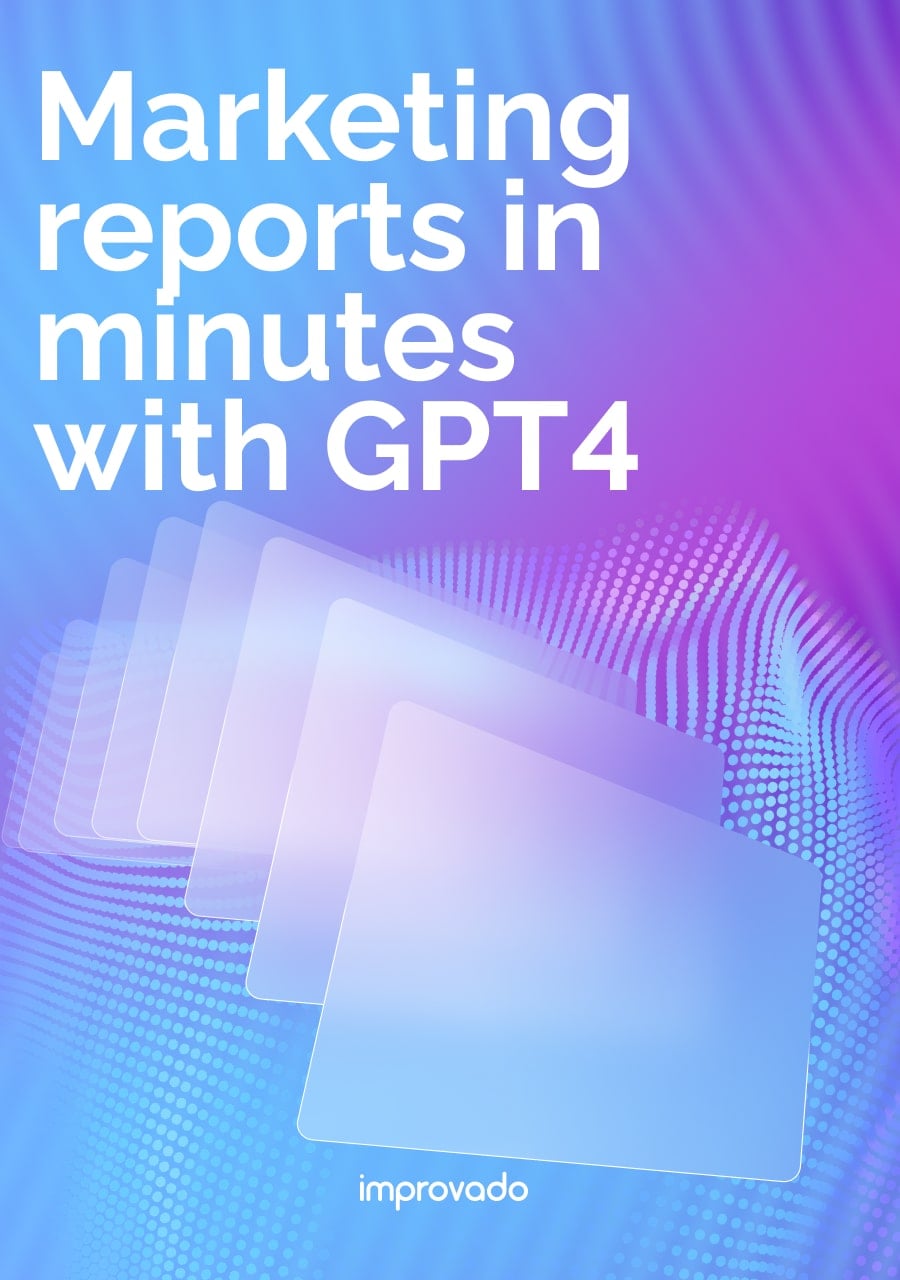Account-based marketing has become the defining strategy for companies pursuing high-value, complex sales cycles. Instead of chasing broad lead volume, ABM aligns marketing and sales around a focused set of target accounts, driving deeper engagement, higher conversion rates, and more predictable revenue outcomes.
This guide breaks down what it takes to build and scale an effective ABM strategy. It covers the core components of successful programs, from data-driven account selection and orchestration frameworks to technology stacks and measurement models.
Key Takeaways
- Account-based marketing (ABM) is a focused B2B strategy where marketing and sales teams work together to target a select list of best-fit, high-value accounts.
- ABM "flips the funnel," starting with account identification and then engaging key decision-makers within those accounts with personalized marketing campaigns.
- Key benefits include stronger sales and marketing alignment, shorter sales cycles, clearer ROI, and improved customer lifetime value.
- A successful ABM program requires a solid tech stack, including data platforms, CRM, marketing automation, and robust analytics tools.
- Implementing ABM involves a clear, step-by-step process, from defining goals and selecting accounts to executing multi-channel campaigns and measuring performance.
What Is Account-Based Marketing (ABM)?
This data-driven marketing strategy is built on the principle of quality over quantity. By concentrating resources on a limited number of best-fit accounts, B2B marketers can create more relevant and impactful customer experiences, leading to larger deal sizes and stronger, long-term relationships.
How ABM Flips the Traditional Marketing Funnel?
Traditional inbound marketing operates like a funnel: cast a wide net with broad content to attract a large number of leads, then nurture them down the funnel until a few become customers. It's a volume game.

ABM flips this model on its head. Instead of a funnel, think of it as a pyramid:
- Identify: At the top, you start by identifying and selecting a small number of high-value target accounts that fit your ideal customer profile (ICP).
- Expand: You then expand your reach within these accounts to map out the key decision-makers and influencers involved in the buying process.
- Engage: You engage these individuals with personalized content and multi-channel campaigns tailored to their specific roles and challenges.
- Convert: The final goal is to convert these engaged accounts into customers and, ultimately, brand advocates.
This targeted approach ensures that every marketing dollar and every sales outreach is spent on accounts that have the highest potential for revenue growth.
The Core Principles of ABM
A successful ABM program is guided by a few foundational principles:
- Sales and Marketing Alignment: ABM is not just a marketing initiative; it’s a unified strategy. Sales and marketing teams must be perfectly aligned on which accounts to target, the messaging to use, and how to measure success.
- Data-Driven Account Selection: The foundation of ABM is choosing the right target accounts. This requires a deep understanding of your ideal customer profile and leveraging firmographic, technographic, and intent data to build a list of best-fit companies.
- Deep Personalization: Generic messaging doesn't work in ABM. Success hinges on creating account-specific content and experiences that resonate with the unique challenges, goals, and industry context of each target account.
- Coordinated, Multi-Channel Engagement: ABM reaches decision-makers across various touchpoints in a cohesive way. This could include targeted digital ads, personalized emails, direct mail, social media outreach, and bespoke events.
- Focus on Measurement and ROI: Every ABM effort must be tracked and measured against key business outcomes, such as pipeline velocity, deal size, and influenced revenue. This ensures the program is delivering clear, demonstrable ROI.
The Three Types of Account-Based Marketing
ABM isn't a one-size-fits-all strategy. It can be implemented at different levels of scale and personalization, depending on your resources and the value of your target accounts.
The three primary types of ABM were originally defined by the Information Technology Services Marketing Association (ITSMA).
One-to-One (Strategic ABM)
This is the most intensive and resource-heavy form of ABM, typically reserved for a handful of top-tier, strategic accounts. Marketing and sales teams create completely bespoke marketing campaigns and content tailored to the specific needs of a single company.
The approach is highly personal, involving deep research into the account's business objectives, challenges, and key stakeholders.
One-to-Few (ABM Lite)
This model applies ABM principles to small clusters of target accounts (typically 5-15) that share similar business attributes, challenges, or industry characteristics. While the campaigns are not entirely unique to each account, the messaging and content are customized to resonate with the specific needs of the cluster.
This approach allows for a degree of personalization at a greater scale than one-to-one ABM.
One-to-Many (Programmatic ABM)
This is the most scalable type of ABM, leveraging technology to apply personalization to a larger list of target accounts (hundreds or even thousands). While the personalization is less deep than in the other two models, programmatic ABM uses account-specific data to tailor digital advertising, website content, and email nurturing at scale.
This is often a great starting point for companies new to ABM.
| Criteria | One-to-One ABM | One-to-Few ABM | One-to-Many ABM |
|---|---|---|---|
| Scope and Focus | Targets a select group of strategic, high-value accounts with individual plans. | Focuses on clusters of 5–50 accounts that share similar attributes, industries, or challenges. | Engages hundreds or thousands of accounts using automation and data-driven targeting. |
| Personalization Level | Deeply customized, messaging, content, and outreach tailored to each account. | Moderately personalized, content and campaigns aligned to shared traits or industry needs. | Light personalization using dynamic content, intent signals, and predictive data. |
| Execution Approach | Highly manual, collaborative effort between marketing and sales teams. | Mix of manual and automated workflows, often supported by templates and scalable assets. | Fully automated, leveraging programmatic advertising, marketing automation, and AI. |
| Resources Required | High, dedicated teams and significant investment per account. | Moderate, balance between effort and efficiency across grouped accounts. | Low per account, driven by technology platforms and data infrastructure. |
| Best Suited For | Large enterprise or strategic accounts with complex buying cycles and high contract value. | Mid-market or vertical-specific campaigns where accounts share similar needs. | Broad-based awareness and demand generation across defined market segments. |
| Key Benefits | Strengthens relationships, improves retention, and drives long-term revenue expansion. | Balances personalization and scalability, delivering efficient pipeline growth. | Maximizes reach and efficiency, fueling top-of-funnel engagement at scale. |
Key Benefits of an ABM Strategy
Adopting an ABM strategy can deliver significant, measurable results that go far beyond traditional lead generation metrics. By focusing on best-fit accounts, businesses can drive efficiency and revenue growth across the board.
Stronger Sales and Marketing Alignment
ABM forces sales and marketing teams to break down silos and work as a single, cohesive unit. They must agree on target accounts, develop joint messaging, and coordinate outreach efforts. This shared accountability eliminates friction, fosters collaboration, and ensures both teams are focused on the same goal: winning high-value accounts.
Shorter Sales Cycles & Higher Conversion Rates
A report by Gartner showed that the average B2B buying decision is typically influenced by 6 to 10 stakeholders. A different study by CSO insights reports that nearly half (46.4%) of every B2B sales process takes up to seven months to complete.
Because ABM targets accounts that are already a good fit for your product or service, you spend less time nurturing unqualified leads. The personalized, multi-channel approach warms up key decision-makers before sales even makes the first call.
This pre-engagement significantly shortens the sales cycle and leads to higher conversion rates from initial contact to closed-won deals.
Clearer, More Measurable ROI
Unlike broad-based marketing where it can be difficult to attribute revenue to specific activities, ABM provides a direct line of sight between marketing efforts and business outcomes. You are tracking engagement, pipeline, and revenue from a defined list of accounts.
This makes it much easier to measure the return on investment of your marketing campaigns and prove their impact on the bottom line.
According to ITSMA, 85% of marketers that measure ROI confirm that ABM delivers better ROI than other marketing tactics.
Efficient Use of Marketing Resources
Instead of spreading your budget thinly across a wide audience, ABM concentrates your resources where they will have the greatest impact. Every piece of content, every ad campaign, and every event is designed for a specific set of high-value accounts. This targeted approach eliminates wasted spend and maximizes the efficiency of your marketing budget.
Improved Customer Relationships and Lifetime Value
The personalization inherent in ABM doesn't stop once a deal is closed.
The deep understanding you gain about your target accounts during the sales cycle helps foster stronger, more strategic relationships post-sale. This leads to higher customer satisfaction, increased loyalty, and greater opportunities for upselling and cross-selling, ultimately increasing customer lifetime value (CLV).
In fact, more than half (58%) of surveyed professionals report that ABM plays a significant role in making their organizations more customer-centric, according to a study by ITSMA and ABM Leadership Alliance.
Core Components of a Successful ABM Program
A successful ABM program is built on a foundation of four critical components. Mastering each of these is essential for driving engagement and revenue from your target accounts.
Strategic Account Selection and Ideal Customer Profile (ICP)
This is the most important step.
Your success depends on targeting the right accounts. Start by defining a crystal-clear Ideal Customer Profile (ICP) based on the characteristics of your best current customers. Use firmographic data (like company size, industry, revenue) and technographic data (the technologies they use) to build a model of your perfect account.
Then, leverage third-party intent data to identify which of these accounts are actively researching solutions like yours.
Deep Account Research and Insights
Once you have your target account list, you need to go deep. Research each account's business goals, financial performance, internal challenges, and key initiatives. Identify the primary decision-makers and influencers within the buying committee. Map out their roles, responsibilities, and pain points.
The goal is to gather enough insight to make your outreach feel personal and highly relevant.
Personalized Content and Messaging
Armed with deep insights, you can move beyond generic messaging. Create content like blog posts, whitepapers, case studies, and landing pages that speaks directly to the challenges and industry context of your target accounts.
Tailor your email outreach, ad copy, and sales scripts to address the specific needs of the key decision-makers you identified.
The more personalized your approach, the more likely you are to cut through the noise.
Coordinated Multi-Channel Engagement
ABM is not a single-channel effort. It requires a symphony of coordinated touchpoints across multiple channels. This could include targeted display ads on industry websites, sponsored content on LinkedIn, personalized email sequences, high-touch direct mail, and strategic outreach from your sales team.
The key is to ensure the messaging is consistent and the experience is seamless across all channels.
How to Build and Implement Your ABM Strategy in 7 Steps
Ready to launch your own ABM program? Follow this step-by-step guide to build a robust and effective strategy from the ground up.
Step 1: Define Your Goals and Align Sales & Marketing Teams
Before you do anything else, get your sales and marketing leaders in the same room. Define what success looks like for your ABM program. Are you aiming for higher deal sizes, increased pipeline velocity, or breaking into a new market?
Set clear, measurable goals (KPIs) and establish a service-level agreement (SLA) that outlines the roles and responsibilities of each team. This alignment is non-negotiable.
Step 2: Identify and Select Your High-Value Target Accounts
Using the ICP you developed, build your target account list. Start with your existing customer data to identify common attributes of your most successful clients.
Then, use data providers like Demandbase or ZoomInfo to find other companies that fit this profile. Layer on intent data to prioritize accounts that are actively showing buying signals. Aim for a manageable list that your sales team can realistically focus on.
Step 3: Map Key Roles and Research Account Needs
For each target account, identify the key players in the buying committee. This typically includes decision-makers, champions, influencers, and blockers. Use tools like LinkedIn Sales Navigator to map out the organizational structure and find the right contacts.
Research their individual pain points and professional goals to understand how your solution can help them succeed.
Step 4: Create Personalized Content and Campaigns
Develop a content map that aligns with the buyer's journey for your target accounts. Create or repurpose high-value assets like industry reports, webinars, and case studies that address their specific challenges.
For a one-to-one or one-to-few approach, create account-specific content, such as a customized pitch deck or a personalized ROI calculator.
Step 5: Choose Your Channels and Tools
Select the channels where your target audience is most active. Your multi-channel marketing strategy will likely include a mix of email marketing, LinkedIn advertising, content syndication, and direct sales outreach.
Make sure you have the right ABM tools in place to execute and manage these campaigns effectively.
Step 6: Execute Your ABM Campaigns
Launch your coordinated campaigns. Sales and marketing must work in lockstep. As marketing warms up the account with targeted ads and content, sales should follow up with timely, relevant, and personalized outreach. Track all touchpoints in your CRM to maintain a complete view of account engagement.
Step 7: Measure, Analyze, and Optimize Performance
Consistently track your progress against the goals you set in Step 1. Key ABM metrics to monitor include:
- Target Account Coverage: Are you reaching the key decision-makers in your target list?
- Account Engagement: Are your target accounts visiting your website, opening emails, and interacting with your content?
- Pipeline Velocity: How quickly are target accounts moving through the sales cycle?
- Deal Size: Are deals from target accounts larger than non-ABM deals?
- Win Rate: Is your close rate higher for target accounts?
Use these insights to refine your targeting, messaging, and overall strategy.
Common ABM Challenges and How to Overcome Them
While ABM offers immense benefits, it's not without its challenges. Being aware of these common hurdles can help you proactively address them and keep your program on track.
Challenge 1: Achieving True Sales and Marketing Alignment
The Problem: Even with a shared revenue goal, sales and marketing teams often operate with different incentives, KPIs, and time horizons. Marketing focuses on engagement and pipeline generation, while sales prioritizes late-stage conversion and deal velocity. Without unified visibility, both teams optimize for different outcomes.
The Solution: Establish a formal SLA from the outset. Hold regular joint meetings to review progress, discuss challenges, and plan upcoming campaigns. Use a shared dashboard with agreed-upon metrics to ensure both teams are looking at the same data and working toward the same objectives.
Challenge 2: Selecting the Right Accounts
The Problem: Choosing the wrong accounts is one of the fastest ways to fail at ABM. If you target companies that aren't a good fit or aren't in-market, you'll waste significant resources with little to show for it.
The Solution: Invest time in building a data-driven ICP. Don't rely on guesswork. Use a combination of firmographic, technographic, and intent data to build and prioritize your list. Involve your top sales reps in the selection process, they often have valuable frontline insights.
Challenge 3: Scaling Personalized Content Creation
The Problem: Personalization drives ABM success, but building bespoke campaigns for every account is resource-intensive. Creative and content teams often hit production bottlenecks, slowing execution and diminishing campaign agility.
The Solution: Adopt a tiered personalization framework.
- Reserve one-to-one campaigns for strategic accounts with the highest revenue potential.
- For one-to-few programs, use modular content templates customizable by industry, use case, or persona.
- At scale, leverage dynamic content engines and marketing automation tools to personalize messaging based on account-level attributes or intent signals.
This structured approach ensures personalization at scale without overextending production resources.
Challenge 4: Managing Data and Technology Integration
The Problem: ABM depends on unified data across platforms, including CRM, marketing automation, web analytics, ad networks, and intent tools. Yet, these systems rarely speak the same language. Fragmented data leads to inaccurate targeting, incomplete engagement views, and unreliable reporting.
The Solution: Consolidate your ABM data architecture with a centralized platform like Improvado. It automates data extraction and normalization across 500+ marketing, sales, and advertising sources, eliminating silos and manual reconciliation. With governed, cross-channel data pipelines, both sales and marketing teams gain real-time visibility into account activity, enabling consistent targeting, better segmentation, and precise engagement measurement.
Challenge 5: Measuring ABM Performance and Proving ROI
The Problem: With so many moving parts and touchpoints, attributing revenue to specific ABM activities can be complex. If you can't prove ROI, you'll struggle to secure an ongoing budget and buy-in for your program.
The Solution: Proving the ROI of a multi-touch ABM campaign is notoriously difficult with siloed data. To accurately measure metrics like influenced pipeline and sales cycle length, teams need a unified view of the entire customer journey. Platforms like Improvado solve this by consolidating all marketing and sales data, making it easy to build comprehensive dashboards in your BI tool that tie ABM activities directly to revenue outcomes.
Essential ABM Tools and Technology
Executing a sophisticated ABM strategy requires a well-integrated MarTech stack. These are the core categories of tools you'll need to power your program.
Account Data and Intelligence Platforms
These tools (like Demandbase, 6sense, or ZoomInfo) are the foundation of your ABM efforts. They provide the firmographic, technographic, and intent data you need to identify and prioritize your target accounts. They help you uncover which companies are in-market for your solution right now.
Marketing Automation & CRM
Your CRM (like Salesforce) is your central repository for all account and contact information. Your Marketing Automation Platform (like HubSpot or Marketo) is used to execute personalized email nurturing, score account engagement, and manage campaign workflows. Tight integration between these two systems is crucial.
Advertising and Retargeting Tools
Platforms like LinkedIn, Terminus, and RollWorks allow you to run targeted advertising campaigns aimed specifically at your list of target accounts. You can serve personalized display ads, sponsored content, and video ads to key decision-makers within those companies, keeping your brand top-of-mind.
Analytics and Reporting Platforms
To measure the effectiveness of your multi-channel campaigns, you need a way to bring all your data together. Traditional analytics tools often fall short because they can't connect data from all your different marketing and sales systems.
To power your ABM analytics, you need a platform that can handle data from hundreds of marketing and sales sources without manual intervention. Improvado provides enterprise-grade data pipelines that automatically extract, transform, and load marketing data into any destination, ensuring your analytics team has a reliable, unified dataset to measure ABM effectiveness.
Real-World Examples of Winning ABM Campaigns
Theory is great, but seeing ABM in action provides a clearer picture of what's possible. Here are a few examples that illustrate different ABM tactics.
Example 1: Bespoke Content Hubs
Snowflake, a cloud data platform, executed a brilliant one-to-few ABM campaign by creating bespoke content experiences for different industry verticals. They built customized content hubs with case studies, articles, and research reports specifically tailored to the challenges of the financial services, healthcare, and retail industries.
Prospects from target accounts were driven to these hubs via personalized ads, providing them with a highly relevant and valuable content journey.
Example 2: High-Touch Direct Mail
In a bid to win over T-Mobile as a client, the CMO of GumGum (a computer vision company) began by researching the target company’s buying committee, starting from the executive leadership team.
The CMO discovered that T-Mobile’s CEO at that time, John Legere, was a big Batman fan. With this information, the CMO and his team went on to set the gold standard for personalized ABM marketing.
Here’s how GumGum got the attention of John Legere and ultimately won him over:
The team developed a comic book, T-Man and Gums, featuring Legere as the Batmanesque superhero—T-Man—who rescues his city from bad cell phone service with the help of his partner, Gums.
In the comic book, Gums provides T-Man with image-recognizing marketing tech that helps him spread the word about T-Mobile.
Not only did this move land GumGum a meeting appointment with T-Mobile, but it also gave the company free exposure, thanks to John Legere’s shoutout on Twitter.
I love this!! Thank you @GumGum for making this epic comic book about @TMobile. Go #Tman!!! https://t.co/ygzWVS947d pic.twitter.com/wFp8CAiGz1
— John Legere (@JohnLegere) November 29, 2016
GumGum’s move is resource intensive and is best reserved for top-tier clients.
Here’s how you can achieve something similar (the cheaper way):
- Gather as much intel as possible about your target clients.
- Find the specific individuals responsible for moving the needle around your target company’s buying processes.
- Create engaging, personalized, and impactful content for these individuals and try to spark a conversation.
Conclusion
Account-Based Marketing only works when teams can clearly see what’s driving results. Targeting the right accounts and running personalized campaigns is valuable, but without reliable performance data, it’s impossible to prove ROI or scale what works. The real challenge for most organizations is connecting engagement metrics, pipeline activity, and revenue outcomes into one coherent view.
Improvado makes that possible. It unifies marketing and sales data from every ABM tool, giving teams real-time visibility into account performance and revenue impact. With automated data governance, AI-powered monitoring, and centralized reporting, Improvado helps enterprises measure influence, identify what drives conversion, and optimize campaigns at every stage of the funnel.
.png)



.png)
